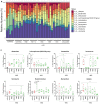Fish-Derived Protein Hydrolysates Increase Insulin Sensitivity and Alter Intestinal Microbiome in High-Fat-Induced Obese Mice
- PMID: 37367668
- PMCID: PMC10302332
- DOI: 10.3390/md21060343
Fish-Derived Protein Hydrolysates Increase Insulin Sensitivity and Alter Intestinal Microbiome in High-Fat-Induced Obese Mice
Abstract
Obesity and type 2 diabetes are characterized by low-grade systemic inflammation and glucose intolerance, which can be partially controlled with nutritional interventions. Protein-containing nutritional supplements possess health-promoting benefits. Herein, we examined the effect of dietary supplementation with protein hydrolysates derived from fish sidestreams on obesity and diabetes, utilizing a mouse model of High-Fat Diet-induced obesity and type 2 diabetes. We examined the effect of protein hydrolysates from salmon and mackerel backbone (HSB and HMB, respectively), salmon and mackerel heads (HSH and HMH, respectively), and fish collagen. The results showed that none of the dietary supplements affected weight gain, but HSH partially suppressed glucose intolerance, while HMB and HMH suppressed leptin increase in the adipose tissue. We further analyzed the gut microbiome, which contributes to the metabolic disease implicated in the development of type 2 diabetes, and found that supplementation with selected protein hydrolysates resulted in distinct changes in gut microbiome composition. The most prominent changes occurred when the diet was supplemented with fish collagen since it increased the abundance of beneficial bacteria and restricted the presence of harmful ones. Overall, the results suggest that protein hydrolysates derived from fish sidestreams can be utilized as dietary supplements with significant health benefits in the context of type 2 diabetes and diet-induced changes in the gut microbiome.
Keywords: diabetes; fish; microbiome; obesity; protein hydrolysates.
Conflict of interest statement
The authors declare no conflict of interest.
Figures





Similar articles
-
Diet Supplementation with Fish-Derived Extracts Suppresses Diabetes and Modulates Intestinal Microbiome in a Murine Model of Diet-Induced Obesity.Mar Drugs. 2021 May 11;19(5):268. doi: 10.3390/md19050268. Mar Drugs. 2021. PMID: 34064922 Free PMC article.
-
Fish Sidestream-Derived Protein Hydrolysates Suppress DSS-Induced Colitis by Modulating Intestinal Inflammation in Mice.Mar Drugs. 2021 May 28;19(6):312. doi: 10.3390/md19060312. Mar Drugs. 2021. PMID: 34071180 Free PMC article.
-
Animal and Cellular Studies Demonstrate Some of the Beneficial Impacts of Herring Milt Hydrolysates on Obesity-Induced Glucose Intolerance and Inflammation.Nutrients. 2020 Oct 22;12(11):3235. doi: 10.3390/nu12113235. Nutrients. 2020. PMID: 33105775 Free PMC article.
-
Crosstalk between intestinal microbiota, adipose tissue and skeletal muscle as an early event in systemic low-grade inflammation and the development of obesity and diabetes.Diabetes Metab Res Rev. 2015 Sep;31(6):545-61. doi: 10.1002/dmrr.2617. Epub 2014 Dec 8. Diabetes Metab Res Rev. 2015. PMID: 25352002 Review.
-
Pulse Proteins and Their Hydrolysates: A Comprehensive Review of Their Beneficial Effects on Metabolic Syndrome and the Gut Microbiome.Nutrients. 2024 Jun 12;16(12):1845. doi: 10.3390/nu16121845. Nutrients. 2024. PMID: 38931200 Free PMC article. Review.
Cited by
-
Effects of diets supplemented with bioactive peptides on nutrient digestibility, immune cell responsiveness, and fecal characteristics, microbiota, and metabolites of adult cats.J Anim Sci. 2024 Jan 3;102:skae104. doi: 10.1093/jas/skae104. J Anim Sci. 2024. PMID: 38587063 Free PMC article.
-
Effects of Marine-Derived Components on Cardiovascular Disease Risk Factors and Gut Microbiota Diversity.Mar Drugs. 2024 Nov 20;22(11):523. doi: 10.3390/md22110523. Mar Drugs. 2024. PMID: 39590803 Free PMC article. Review.
-
Anti-Obesity Effects of a Collagen with Low Digestibility and High Swelling Capacity: A Human Randomized Control Trial.Nutrients. 2024 Oct 19;16(20):3550. doi: 10.3390/nu16203550. Nutrients. 2024. PMID: 39458544 Free PMC article. Clinical Trial.
-
Low-Molecular Collagen Peptide Supplementation and Body Fat Mass in Adults Aged ≥ 50 Years: A Randomized, Double-Blind, Placebo-Controlled Trial.Clin Nutr Res. 2023 Oct 31;12(4):245-256. doi: 10.7762/cnr.2023.12.4.245. eCollection 2023 Oct. Clin Nutr Res. 2023. PMID: 37969940 Free PMC article.
References
MeSH terms
Substances
Grants and funding
LinkOut - more resources
Full Text Sources
Medical

